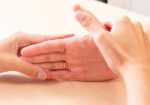Ilter, L., Dilek, B., Batmaz, I., Ulu, M.A., Sariyildiz, M.A., Nas, K., & Cevik, R. (2015). Efficacy of pulsed and continuous therapeutic ultrasound in myofascial pain syndrome: A randomized controlled study. American Journal of Physical Medicine & Rehabilitation, 94(7), 547-554. https://doi.org/10.1097/PHM.0000000000000210
Review by: Megan Prather
The Skinny- Ultrasound hand therapy – ultrasound has been determined as an effective method for use in treatment of myofascial pain syndrome (MPS). Both continuous and pulsed ultrasound have been used with MPS but the two had not previously been compared in a controlled trial. Researchers in this study set out to compare the effects of continuous ultrasound, pulsed ultrasound, and a placebo in MPS to determine best practices for treatment and the use of ultrasound for hand therapy.

In The Weeds- This study was a placebo-controlled, double-blind, randomized controlled trial looking at ultrasound in patients with a diagnosis of MPS with cervicoscapular myofascial pain based on Travell and Simons criteria. Researchers recruited 60 study participants between the ages of 18 and 60 with an active upper trapezius trigger point and pain for at least 1 month who consented to participate. Study participants were divided into one of three groups receiving continuous ultrasound (3 MHz, 1 W/cm2), pulsed ultrasound (3 MHz, 1 W/cm2), or sham ultrasound (machine not on) for 5 minutes 5 days a week for 2 weeks over the painful trigger point. All participants were also instructed in stretching and ROM exercises and received 10 minutes of hot pack treatment. The primary outcome measures for this study were pain at rest and pain with movement. Secondary outcome measures of muscle spasm palpation, psychological state, quality of life, function, and patient satisfaction were also used.
Bringing it Home- Researchers found statistically significant improvement in pain, degree of muscle spasm, neck function, and the Beck Depression Scale quality of life pain subparameter after therapy in all three groups at 6 weeks and 12 weeks after treatment (P<0.05). No significant improvement was found for patient satisfaction or the Beck Depression Scale quality of life social isolation subparameter in any of the groups. Further, in the placebo group no significant improvement was found for the Beck Depression Scale. The group receiving continuous ultrasound showed a statistically significant greater improvement in pain at rest than in either other group (P<0.05). Overall, this study found that continuous ultrasound is better for reducing pain at rest than pulsed ultrasound or placebo in patients with myofascial pain syndrome.

This study was well done and included randomization and blinding of participants into the three groups for clinical comparison. Outcome measures covered a wide range of patient factors and relevant conclusions can be drawn from the data. The smaller participant number and potentially inconsistent exercises done by participants may limit the results. However, these results can positively impact practice and methods used to treat patient pain.
More To Read
Pain management techniques for Wrist Fractures
Pain management techniques for wrist fractures Distal radius fractures account for 17.5% of all fractures with a median age of 60.23(Candela et.al, 2022). Pain management is a significant part of post wrist fracturetreatment due to limitations that pain incurs. Chronic Regional Pain Syndrome (CRPS) canoccur along with a distal radius fracture but will not be…
Read MoreClosed Pulley Injuries in Rock Climbers
Mechanism of injury Grades of pulley injury Treatment options for closed rupture Outcome measures Return to climbing Exercise considerations Resources Bollen S. R. (1990). Upper limb injuries in elite rock climbers. Journal of the Royal College of Surgeons of Edinburgh, 35(6 Suppl), S18–S20. Bosco, F., Giustra, F., Lusso, A., Faccenda, C., Artiaco, S., & Massè, A. (2022).…
Read MoreAssessing and Improving Grip with the Squegg
Assessing and Improving Grip with the Squegg By: Megan Prather “Grip training is made fun” In hand therapy we are always looking for engaging new interventions to use with patients. The Squegg is a dynamic grip-training tool that can be used with clients both to assess grip strength and to improve strength across sessions. This…
Read MoreTennis Elbow and Graded Exercises
Lateral Elbow Pain with Graded Exercise Chronic tennis elbow with a supervised graded exercise protocol Özdinçler, A. R., Baktır, Z. S., Mutlu, E. K., & Koçyiğit, A. (2023). Chronic lateral elbow tendinopathy with a supervised graded exercise protocol. Journal of Hand Therapy, 36(4), 913–922. https://doi.org/10.1016/j.jht.2022.11.005 The Skinny: This study looked at the effectiveness of an…
Read MoreSign-up to Get Updates Straight to Your Inbox!
Sign up with us and we will send you regular blog posts on everything hand therapy, notices every time we upload new videos and tutorials, along with handout, protocols, and other useful information.





